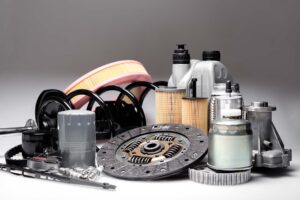Do you ever wonder what causes white smoke from car exhaust when starting the car or cruising down the street? Ever noticed it and immediately started panicking, thinking something is seriously wrong with your vehicle? Don’t worry – it happens more often than you might expect! So, let’s dive into why this issue occurs and what you should do if you’re dealing with it.
When starting the engine in really cold weather conditions, it’s normal for your four-wheeler to let out some white fumes. However, if they persist long after the engine has warmed up, it may indicate a bigger problem, such as a coolant leak, head gasket failure, or clogged fuel injectors.
What Is White Smoke From Car Exhaust?
White smoke refers to the visible exhaust fumes that are emitted from the engine or other combustion processes. Typically white or gray in appearance, the smoke can vary depending on factors such as temperature and humidity of the air, the type of oil or fuel being burned, and the overall condition of the engine.
Here are a few common indicators of that eerie white cloud:
- Smoke is more visible during cold start-up but persists even when the engine has warmed up,
- There’s a sweet odor,
- Fumes are accompanied by a loss of coolant or a decrease in engine performance,
- It’s visible during acceleration or under heavy load,
- Smoke appears only when the engine is idling,
- It’s more visible in humid or wet water conditions.
How It Differs From Black and Blue Smoke?
Unlike white smoke, black and blue fumes are more persistent and have a stronger odor. Black smoke is typically caused by an excess of fuel being burned, which can result from a number of issues, such as a clogged air filter, faulty fuel injectors, or an improperly adjusted carburetor.
On the other hand, blue smoke is often an indication of burning oil and can be caused by worn piston rings, valve seals, or other engine components in the combustion chamber. All in all, black and blue fumes are indicators of more serious problems, but that doesn’t mean that white smoke coming from your car’s exhaust system should be taken lightly.
Any Vehicle Problem Should Be Addressed as Soon as Possible
No matter if you’ve been driving through the cities with the worst drivers or taking road trips through the famous routes in the US, if you’re noticing white smoke coming from your car’s exhaust recently, it’s best to get to the bottom of it as soon as possible.
It might not be as serious as black or blue fumes from your four-wheeler, but it’s still important to address it immediately to avoid further issues. So, let’s get down to the possible culprits and how to solve this problem.

What Are the Causes of White Smoke From Car Exhaust?
White fumes from your four-wheeler can indicate a few problems, depending on when and how it occurs. There are occasions when it’s completely normal to appear, and there are other scenarios that might indicate something more serious is going on.
When It’s Normal and When It’s Not
White exhaust fumes are a common occurrence during cold-start-ups, especially in colder climates, where it’s completely normal. This is because the combustion process produces water vapor that can condense in the exhaust system, resulting in visible fumes escaping outside.
However, if it persists after the engine has warmed up or appears in large amounts, it could be a sign of a problem with the engine, such as a coolant leak or a malfunctioning fuel system. In such cases, it’s important to have the vehicle checked by a mechanic to identify and address the issue.
If the white cloud just won’t go away, here are a few possible reasons behind it:
Coolant Leak
Coolant fluid is a mixture of water and antifreeze that circulates through the engine to maintain the operating temperature within a safe range. When the engine’s cooling system is compromised and allows the coolant to escape from the system, there might be a sweet-smelling white fume from the exhaust pipe, along with overheating, a low coolant level, and visible coolant puddles underneath the four-wheeler.
This white smoke persists even when the engine is all warmed up. So, if you’re noticing this issue it’s best to have your vehicle checked by a mechanic as soon as possible to prevent further damage to the engine.
Cracked Engine Block
A cracked engine block is a serious and costly issue that occurs when the metal block that houses the engine’s cylinders and other components develops a crack. This can cause a loss of engine coolant, which can lead to overheating and further problems.
Aside from visible cracks in the engine block, a common sign that this is the underlying problem is significant amounts of white fumes, along with a low coolant level and possible overheating. Unfortunately, if this is the culprit behind that white cloud that just won’t leave you alone, solving this problem requires an expensive repair and, in some cases, replacing the whole engine. That can put quite a burden on your overall cost of owning a vehicle, and it’s not pretty.
Head Gasket Failure
A head gasket is a seal between the engine block and the cylinder head and is designed to keep coolant and oil from mixing. Its malfunction allows coolant to leak into the engine’s cylinders or combustion chamber, so it has the same outcomes as the first scenario I’ve discussed, including white fumes.
In some cases, a blown head gasket may also cause oil to leak into the coolant system or vice versa. This serious issue requires immediate attention from a knowledgeable mechanic, as it most often leads to further engine damage.
Transmission Fluid Leak
Transmission fluid is essential to lubricate the transmission’s internal components, prevent overheating, and ensure smooth shifting. A leak in the system can cause a wide variety of issues, such as slipping gears and delayed or rough shifting, which can be pretty dangerous, especially if you already deal with driving anxiety.
Leaks in the transmission system can occur when the seal or gasket that keeps the fluid contained gets damaged, and one of the common signs that this has happened can be white fumes emitting from your four-wheeler. Additionally, there might be red or brown fluid puddles underneath the car, low fluid levels, and visible fluid on the transmission or engine.
Clogged Fuel Injectors or a Faulty Fuel Pump
In some cases, white fumes may also indicate a problem with the fuel system, such as a clogged fuel injector or a faulty fuel pump. The first component is responsible for delivering the right amount of fuel into the engine’s cylinders, while the second one ensures that the fuel is delivered at the correct pressure.
This can cause various issues with the engine’s fuel delivery system, resulting in poor engine performance, reduced fuel efficiency, and increased emissions. A clogged fuel injector can cause a lack of power or misfires, while a faulty fuel pump can cause low fuel pressure, leading to poor acceleration or stalling.
How to Diagnose the Problem?
No matter if you own a brand-new vehicle, a used car, or one with a salvage title, diagnosing the cause of the white cloud following you around can be difficult and requires expertise in engine mechanics. But now that you know the common culprits behind this issue, it’ll definitely help in figuring out your next steps.
What to Do When You See White Smoke
As already mentioned, if the white smoke appears only during start-ups on particularly cold days, this is completely normal, and you shouldn’t be alarmed. However, if you’ve been driving for a while but the issue persists, there are a few things you should do immediately.
First things first, you should pull over safely and turn off the engine. If it’s overheating or there are other signs of engine damage we’ve discussed, do not attempt to drive the car any further. No matter what you think is the cause of the issue, it’s best to avoid driving the car until it has been resolved, as continued operation can cause further damage and compromise the safety of the vehicle.
How to Identify the Source of the Smoke?
Once you’ve identified that the color of the fumes is white, there are a couple of things you need to check in order to figure out its source and the possible culprit behind it:
- Check the coolant and oil levels and conditions to see if there are any signs of mixing,
- Inspect the fuel system for clogged fuel injectors or a faulty pump,
- Check for any leaks in the cooling system or fuel system,
- Inspect the exhaust system for damage or leaks,
- Perform a compression or leak-down test to check for a blown head gasket or other engine issues,
- Check for any unusual sounds or smells, such as knocking, rattling noises, or a sweet smell from the coolant.
When to Call a Mechanic?
Your biggest helping hand at identifying the problem is having your four-wheeler checked by a mechanic as soon as possible. Sure, many people avoid doing this in order to cut down expenses, but addressing the problem head-on will actually save you a lot of money in the long run. So, don’t ignore any signs of trouble and seek professional help immediately – it’s better to be safe than sorry.

How to Fix the Issue?
Obviously, the approach to fixing this issue will depend on what caused it. If you’re not sure about that, it’s best to leave it to professionals – they have the expertise and tools to correctly identify the problem and repair it. However, if you’ve identified the underlying problem and you have a bit of mechanical knowledge under your belt, it’s possible to deal with it by yourself.
DIY Fixes for Minor Issues
If you’ve identified that the problem lies with a particular vehicle component you already know how to replace, you can cautiously attempt to fix it. For example, if the culprit is a clogged air filter, this can be replaced relatively easily. Just make sure you upgrade your vehicle with high-quality components, as they will ensure the longevity and functionality of the inner workings of your four-wheeler.

Watch Out for the Warning Signs and You’ll Have a Smooth Ride
All in all, white fumes from your car’s exhaust pipe are not always indicative of a major issue – it’s typically a byproduct of condensation and not something to worry about. Nevertheless, it’s helpful to understand what can cause this strange phenomenon so that you can identify if more serious repairs are needed. Above all, don’t ignore the warning signs. With the right preventative actions taken in time, you’ll be able to efficiently identify the problem and fix it. Have a safe ride!








